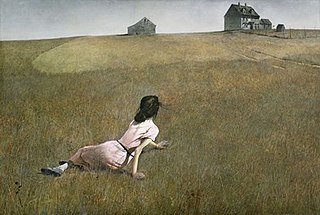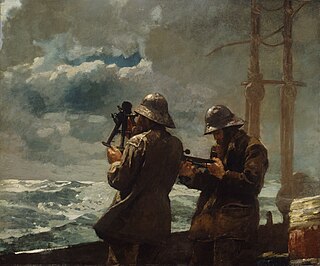
Winslow Homer was an American landscape painter and printmaker, best known for his marine subjects. He is considered one of the foremost painters in 19th-century America and a preeminent figure in American art.

Andrew Newell Wyeth was an American visual artist, primarily a realist painter, working predominantly in a regionalist style. He was one of the best-known U.S. artists of the middle 20th century.

Newell Convers Wyeth, known as N. C. Wyeth, was an American artist and illustrator. He was the pupil of artist Howard Pyle and became one of America's greatest illustrators. During his lifetime, Wyeth created more than 3,000 paintings and illustrated 112 books — 25 of them for Scribner's, the Scribner Classics, which is the body of work for which he is best known. The first of these, Treasure Island, was one of his masterpieces and the proceeds paid for his studio. Wyeth was a realist painter at a time when the camera and photography began to compete with his craft. Sometimes seen as melodramatic, his illustrations were designed to be understood quickly. Wyeth, who was both a painter and an illustrator, understood the difference, and said in 1908, "Painting and illustration cannot be mixed—one cannot merge from one into the other."

James Browning Wyeth is a contemporary American realist painter, son of Andrew Wyeth, and grandson of N.C. Wyeth. He was raised in Chadds Ford Township, Pennsylvania, and is artistic heir to the Brandywine School tradition – painters who worked in the rural Brandywine River area of Delaware and Pennsylvania, portraying its people, animals, and landscape.

Christina's World is a 1948 painting by American painter Andrew Wyeth and one of the best-known American paintings of the mid-20th century. It is a tempera work done in a realist style, depicting a woman semi-reclining on the ground in a treeless, mostly tawny field, looking up at a gray house on the horizon; a barn and various other small outbuildings are adjacent to the house. It is owned by the Museum of Modern Art in New York as part of its permanent collection.

The Brandywine River Museum of Art is a museum of regional and American art located on U.S. Route 1 in Chadds Ford, Pennsylvania on the banks of the Brandywine Creek. The museum showcases the work of Andrew Wyeth, a major American realist painter, and his family: his father N.C. Wyeth, illustrator of many children's classics, his sister Ann Wyeth McCoy, a composer and painter, and his son Jamie Wyeth, a contemporary American realist painter.
The Farnsworth Art Museum in Rockland, Maine, United States, is an art museum that specializes in American art. Its permanent collection includes works by such artists as Gilbert Stuart, Thomas Sully, Thomas Eakins, Eastman Johnson, Fitz Henry Lane, Frank Benson, Childe Hassam, and Maurice Prendergast, as well as a significant collection of works by the 20th-century sculptor Louise Nevelson. Four galleries are devoted to contemporary art.

Bo Bartlett is an American Realist painter working in Columbus, Georgia and Wheaton Island, Maine.

Eight Bells is an 1886 oil painting by the American artist Winslow Homer. It depicts two sailors determining their ship's latitude. It is one of Homer's best-known paintings and the last of his major paintings of the 1880s that dramatically chronicle man's relationship to the ocean.

The Greenville County Museum of Art (GCMA) is an art museum located in Greenville, South Carolina. Its collections focus mainly on American art, and its holdings include works by Andrew Wyeth, Josef Albers, Jasper Johns, Andy Warhol, Romare Bearden, Jacob Lawrence, Ronnie Landfield, Helen Turner, Mary Tannahill, Eric Fischl, Marylyn Dintenfass, and Leon Golub. Southern American and South Carolina-based artists, such as Henrietta Johnston, are also represented.

Tenants Harbor Light, also known as Southern Island Light, is a lighthouse at the mouth of Tenants Harbor, St. George, Maine, United States. It appears in paintings by Andrew Wyeth and his son Jamie Wyeth, who have owned the lighthouse since 1978.

The German Church and Cemetery, also known as the Old German Meeting House, is a historic German Lutheran church and cemetery at 235 Bremen Road in Waldoboro, Maine. Built in 1772, it is a well-preserved 18th-century church, which played an important role in the lives of the area's early German immigrants, and in the establishment of the town of Waldoboro. It was listed on the National Register of Historic Places in 1970.
John Willard McCoy (1910–1989) was an American artist who painted landscapes, portraits, and still lifes. He was married to Ann Wyeth, daughter of N.C. Wyeth and sister of Andrew Wyeth, all artists.

The Helga Pictures are a series of more than 240 paintings and drawings of German model Helga Testorf created by Andrew Wyeth (1917–2009) between 1971 and 1985.

Kuerner Farm, also known as Ring Farm, is a historic farm in Chadds Ford, Pennsylvania, notable for its association with artist Andrew Wyeth, who created about one-third of his work, over 1,000 paintings and drawings, on subjects he found there over a span of 77 years. The farm was listed in the National Register of Historic Places and declared a National Historic Landmark in 2011. The property abuts the Brandywine Battlefield, another National Historic Landmark. The farm is open to public tours, operated by the Brandywine River Museum.

Olson House is a 14-room Colonial farmhouse in Cushing, Maine. The house was made famous by its depiction in Andrew Wyeth's Christina's World. The house and its occupants, Christina and Alvaro Olson, were depicted in numerous paintings and sketches by Wyeth from 1939 to 1968. The house was designated as a National Historic Landmark in June 2011. The Farnsworth Art Museum owns the house; it is open to the public.
Warren Adelson is an American art dealer, art historian, and author specializing in 19th and 20th-century American Painting as well as contemporary art.

Wind from the Sea is a 1947 painting by the American artist Andrew Wyeth. It depicts an inside view of an open attic window as the wind blows the thin and tattered curtains into the room.

Evening at Kuerners is a 1970 painting by the American artist Andrew Wyeth. It is one of Wyeth's paintings of the Kuerner Farm in Chadds Ford, Pennsylvania. The white farmhouse and a smaller outbuilding are depicted at sunset. In the foreground are also two leafless trees and a stream of water which runs from a nearby pond.
American composer, pianist and painter Ann Wyeth McCoy was the youngest daughter of artist-illustrator N.C. Wyeth and the fourth of his five children. She was born in Chadds Ford, Pennsylvania. Ann had a life-long interest in antique porcelain dolls, which began in 1923 when she received her first doll as a gift from her parents on her eighth birthday. Each subsequent birthday and Christmas during her childhood, she received another doll. From 1972 to 2004 her doll collection was exhibited at the Brandywine River Museum in Chadds Ford during the Christmas holidays.

















